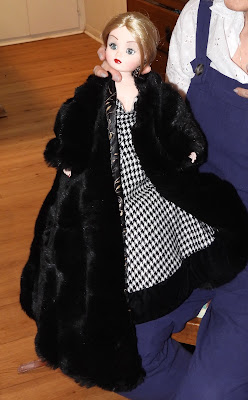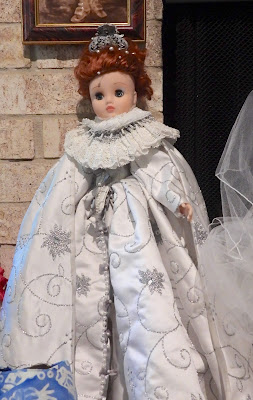Member Elaine McNally did a program on so-called Motschmann or taufling dolls. She explained that although they are called different names by collectors and come in a variety of materials and styles, what the dolls have in common are a solid chest and pelvis connected by fabric, often covering a squeaker or voice box, and cloth inserts at the shoulders and thighs, giving the dolls the floppiness of an infant. Some dolls may also have swivel necks and jointed wrists and ankles. Elaine said that these dolls were inspired by a type of Japanese play doll called ichimatsu, which has the same "floating" limbs. In 1853, American Commodore Mathew Perry sailed into Tokyo harbor to re-establish trade and contact with Japanese, who had closed off their country to most foreigners. Among the artifacts brought back by Perry were Japanese dolls. German companies began manufacturing dolls with similar bodies in papier mache, sometimes with a wax coating, and china. The dolls often resembled babies with round bald heads, sometimes with little tufts of hair painted by their ears, hence the name "taufling," meaning a very young infant. However, dolls also were made with hairstyles or features associated with older children. Christoph Motschmann patented a voice box that was used in many of these dolls; an early collector seeing the Motschmann name on one such doll mistakenly thought Motchmann had made the doll, when in fact he had simply designed the voice box. The tallest standing doll is an antique, while the two other standing dolls are creations by Elaine.
This doll with molded hair was a gift to Elaine from a friend. It is papier mache with a wax coating.
The tallest doll with a curly mohair wig has a voice box operated by a pull string and clearly cries "Papa." Standing in front of this doll is a traditional Japanese ichimatsu doll. The little doll next to her is wax over papier mache and wears her original clothing.
Member Sharon Weintraub displayed these two Japanese ichimatsu dolls. The lady doll is unusual because most ichmatsu resemble young boys or girls and the child doll has a bisque head, rather than the traditional head with a complexion made of gofun, a smooth white coating made from crushed oyster shells.
Sharon also shared this scarce china version with inset glass eyes. Although unmarked, the head resembles the rare glass-eyed china head dolls made by the German company of Kloster Veilsdorf. This poor little guy is waiting to be restored, but the squeak box in his torso still works.
Member Elaine Jackson brought this example with sleeping eyes. She has a squeaker, but lacks floating hands or feet.
Member Pam Harding displayed this beautiful Bye-lo baby. She said that she had wanted one for a long time.
She also shared this stockinette doll with large painted eyes made in 1976. The doll is supposed to represent Betsy Ross.
Member Jan Irsfeld told the club how she found, restored, and dressed this lovely Cissy doll by Madame Alexander.









































